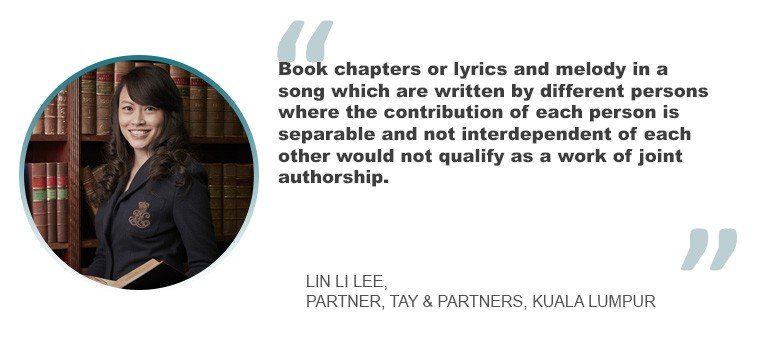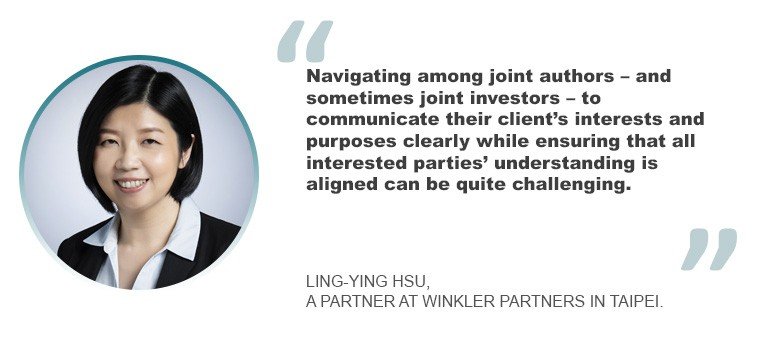Joint authorship and copyright
31 August 2022

Under copyright law, an author is someone who creates an original work in any medium of expression. The literary author who wrote the novel, the musician who composed the lyrics to a song, the artist who made the painting and the screenwriter who wrote the screenplay for a film are all authors.
At times, a piece of work has only one author.
But in certain cases, it has multiple authors. Such initiative is called joint authorship.
Joint authorship is different from co-authorship.
In co-authorship, two or more authors have distinct contributions to a work.

“Book chapters or lyrics and melody in a song which are written by different persons where the contribution of each person is separable and not interdependent of each other would not qualify as a work of joint authorship. In such cases, the copyright of the specific chapter or the melody or lyrics would vest solely in the respective author,” explained Lin Li Lee, a partner and head of intellectual property at Tay & Partners in Kuala Lumpur.
Joint authorship, meanwhile, involves the collaboration of two or more authors for a work wherein each author’s specific contribution is not distinct or separable from the contribution of the other author or authors.
Blake Carey, a senior associate at AJ Park in Auckland, shared that under Section 6(1) of the New Zealand Copyright Act 1994, the following are key factors constituting joint authorship:
-
All the collaborators must be “authors”, in that they must have contributed to creating the relevant work. It is not necessary that all authors contribute to the same extent.
-
The work is produced by collaboration, that is in furtherance of some common design.
-
The contribution of each author is not distinct, i.e., cannot be separately identified.
“These factors are present in copyright statutes in other jurisdictions, for example the United Kingdom’s Copyright, Designs and Patents Act 1988, Section 10(1),” said Carey.
“It is notable that there is no requirement for there to be an intention or agreement between the authors to create a joint work,” said Lee.

Copyright share
Do joint authors have an equal share of the copyright?
“Yes! Joint authors enjoy all rights available to a single author,” said Dhruv Goel, managing associate at Remfry & Sagar in Gurugram.
“In fact, the term of protection of any work can technically be longer as for works of joint authorship. The term of expiry is calculated from the beginning of the calendar year next following the year when the last author dies. Similarly, for anonymous and pseudonymous works, where identity of any one author is disclosed, the term of protection is calculated as above and not 60 years from the date of publication as is the case with anonymous and pseudonymous works of a single author,” added Goel.
“Unless otherwise provided in an agreement or the surrounding circumstances indicate otherwise, joint authors would generally have an equal share of the copyright in a work of joint authorship,” said Lee.
“The effect of Section 8(1) of the NZ Copyright Act 1994 is that the unanimous consent of all joint authors is generally required to deal with the work, regardless of the size of each author’s contribution,” said Carey.
Section 8(1) of the Act states:
“Where copyright or any aspect of copyright is owned by more than one person jointly, references in this Act to the copyright owner, or to the owner of the copyright work, are to all owners.”
“Unless otherwise agreed to among joint authors, each author's share in copyright ownership is proportional to the author's contribution to a jointly created work. When it is unclear what portion/percentage of a work is attributable to each author, the law assumes that all joint authors have equal shares of ownership interest in a jointly created work,” added Ling-ying Hsu, a partner at Winkler Partners in Taipei.

Challenges of joint authorship
One of the potential challenges in the joint authorship copyright sphere is determining whether joint authorship exists at all in a piece of work. This becomes problematic when the authors or alleged authors cannot present clear evidence of who contributed to the work in question.
“In this scenario, there is risk that a third party will allege they are a joint author of a successful work in order to claim a slice of the royalties,” said Carey.
He added that determining the duration of copyright protection for jointly authored works poses another problem.
“Under New Zealand law, copyright generally expires 50 years after the death of the last author. Where there are joint authors, the clock will start ticking on the death of the last joint author. For works contributed by many individuals, it can therefore be difficult to ascertain exactly when copyright expires,” he explained.
As with joint authorship of other types of IP, copyright assignments and licenses would have to be signed by all the joint authors. Herein lies another potential dilemma.
“For works where several joint authors are involved, tracing them all and bringing them on the ‘same page’ could be a challenge,” said Goel.
Hsu agrees. “IP attorneys often act as counsel for one but not all of the joint authors of a work,” she said. “Navigating among joint authors – and sometimes joint investors – to communicate their client’s interests and purposes clearly while ensuring that all interested parties’ understanding is aligned can be quite challenging.”
This could curtail future creative endeavours and extensions, according to Goel who shared details from the following court cases:
In Angath Arts Private Limited v. Century Communications Ltd [2008(4) BomCR838], the Bombay High Court held that “respondents cannot exploit the copyright singly or individually. The exploitation of the copyright must be jointly made by the petitioner and respondents as they are the joint owner.”
Meanwhile, in Nav Sahitya Prakash And Ors. v. Anand Kumar And Ors. [AIR 1981 All 200], the Allahabad High Court stated that “a joint owner of copyright could not without the consent of the other joint owner grant a license or interest in the copyright.”
However, joint authors are not required to act together to initiate a copyright infringement suit. Any one among these joint authors can act on behalf of the others.
Goel pointed out the Allahabad High Court’s ruling in the same case. Reiterating the Halsburys Laws of England 3rd Edition, Vol, III, para 738, the court said that “one joint author cannot reproduce the work himself, or grant licence to others to reproduce it, without the consent of other author or authors, but may by himself take proceedings for infringement against third party.”

Navigating these challenges
To address these challenges, Carey said: “We would typically prepare an agreement setting out, among other things, the rights and powers of each joint author, whether the authors hold copyright in differing shares, how commercial licensing and assignments work and how each author will be compensated.”
Thus, those engaged in joint authorship should agree in writing the details and arrangements pertaining to the above, before they begin working on the collaborative piece.
“They should also keep clear records of when they made a contribution, the size of their contribution and the impact of their contribution to the work as a whole,” Carey emphasized.
According to Goel, it may be best to assign all rights to a single author such as the head of the team.
“This would ensure that further assignments or licenses would be easier to execute. Distribution of royalties or consideration may be clearly defined in the agreement to avoid any future disputes,” Goel explained.
According to Hsu, naming a representative among the group of joint authors to exercise their jointly-owned rights in a work is especially recommended by IP attorneys if the work will be widely licensed.
“Alternatively, clients are also well-advised to divide the rights and responsibilities in connection with a jointly created work among joint authors/investors according to each party’s area of expertise. For instance, one who specializes in marketing channels may be tasked with licensing the work to appropriate channels, while one with expertise in merchandising may be responsible for licensing to create merchandise and collecting related royalties,” she said.
Hsu’s firm generally recommends keeping the number of contributors to a joint authorship venture as low as possible. The objective is to avoid the difficulties involved in obtaining all joint authors’ consent to exercise their rights as well as complications arising from division of ownership interests.
A formal registration with the Copyright Office likewise often helps in identifying and establishing the owner(s)/author(s) of any work. Aside from providing a prima facie evidence of copyright ownership, copyright registration also assists in enforcement actions as it eliminates time and effort spent to establish ownership first before proceeding to establish the commission of copyright infringement.
Some creative works need joint authorship in order for these to take shape and come into fruition. But, joint authorship comes with its own set of challenges. Therefore, it is important for participants in a joint authorship venture to know the law, be aware of these pitfalls and take appropriate action even before setting out to do the job.






